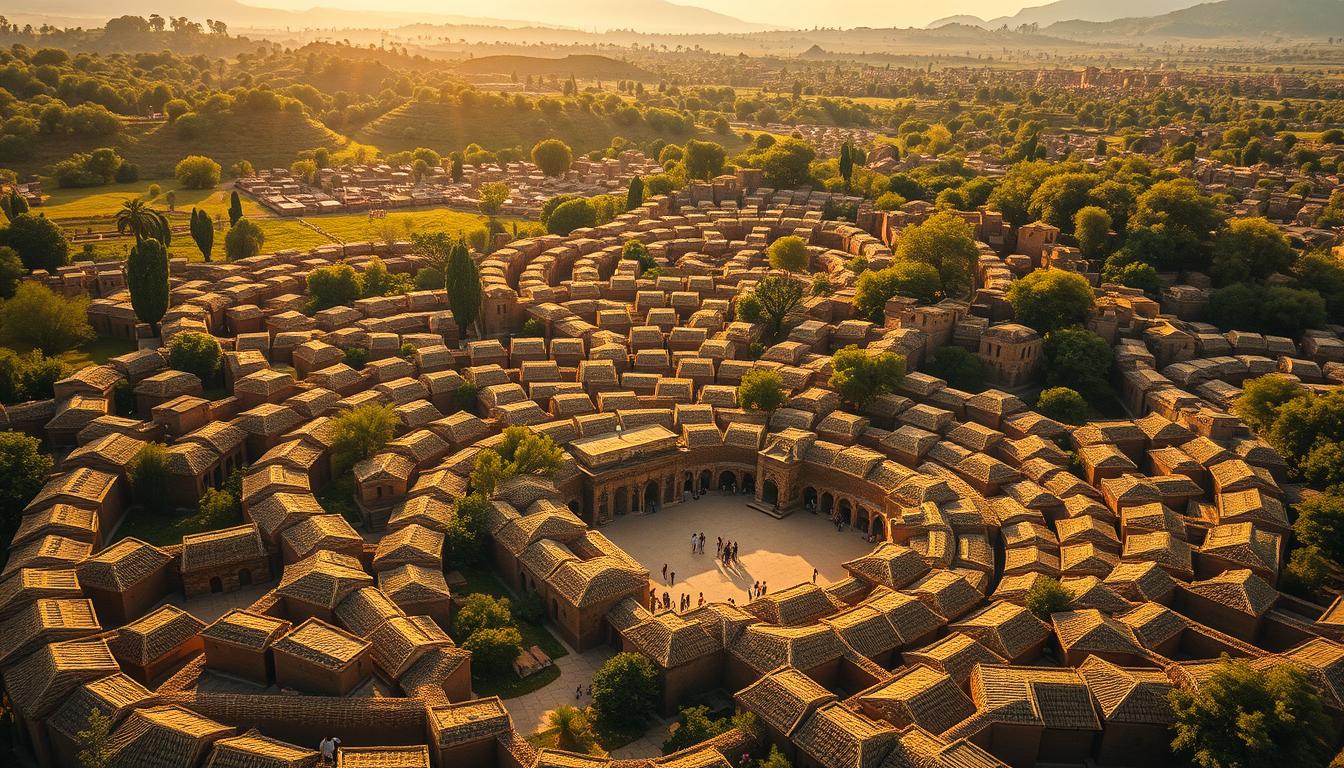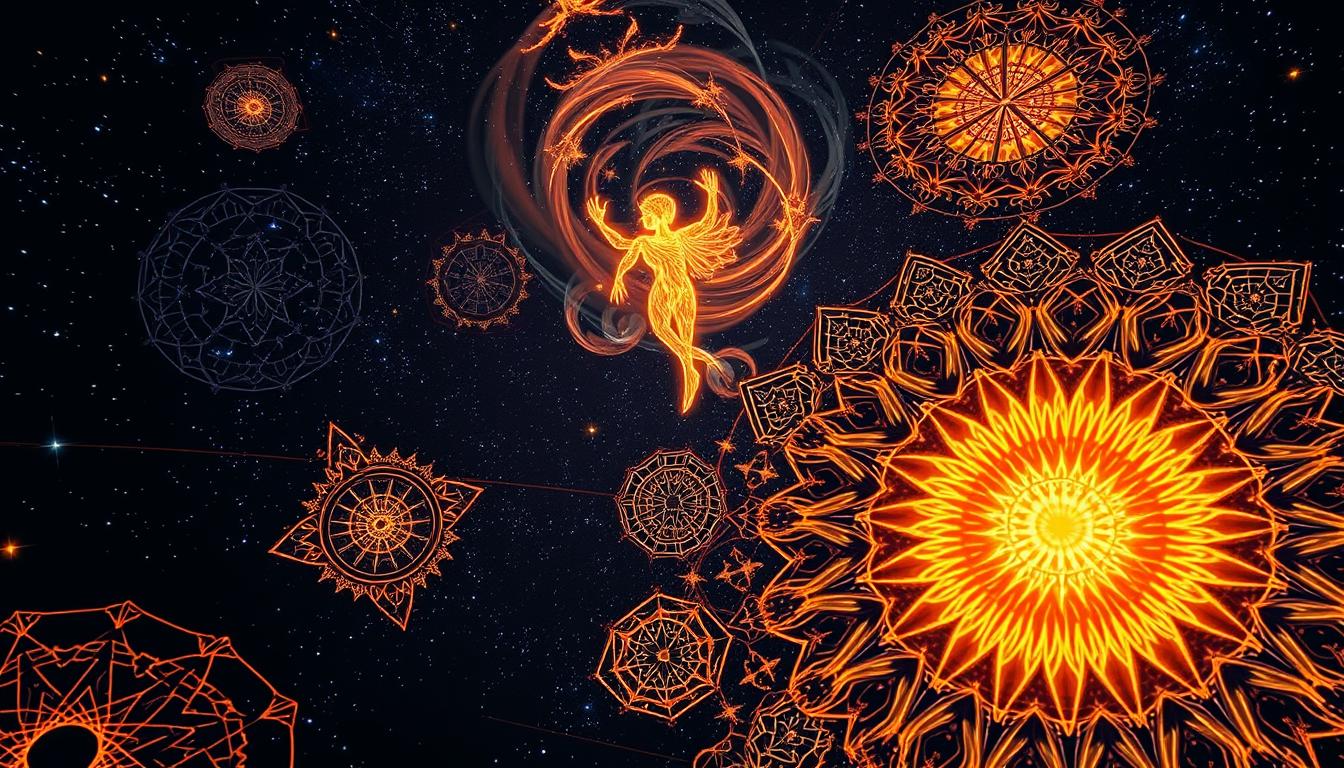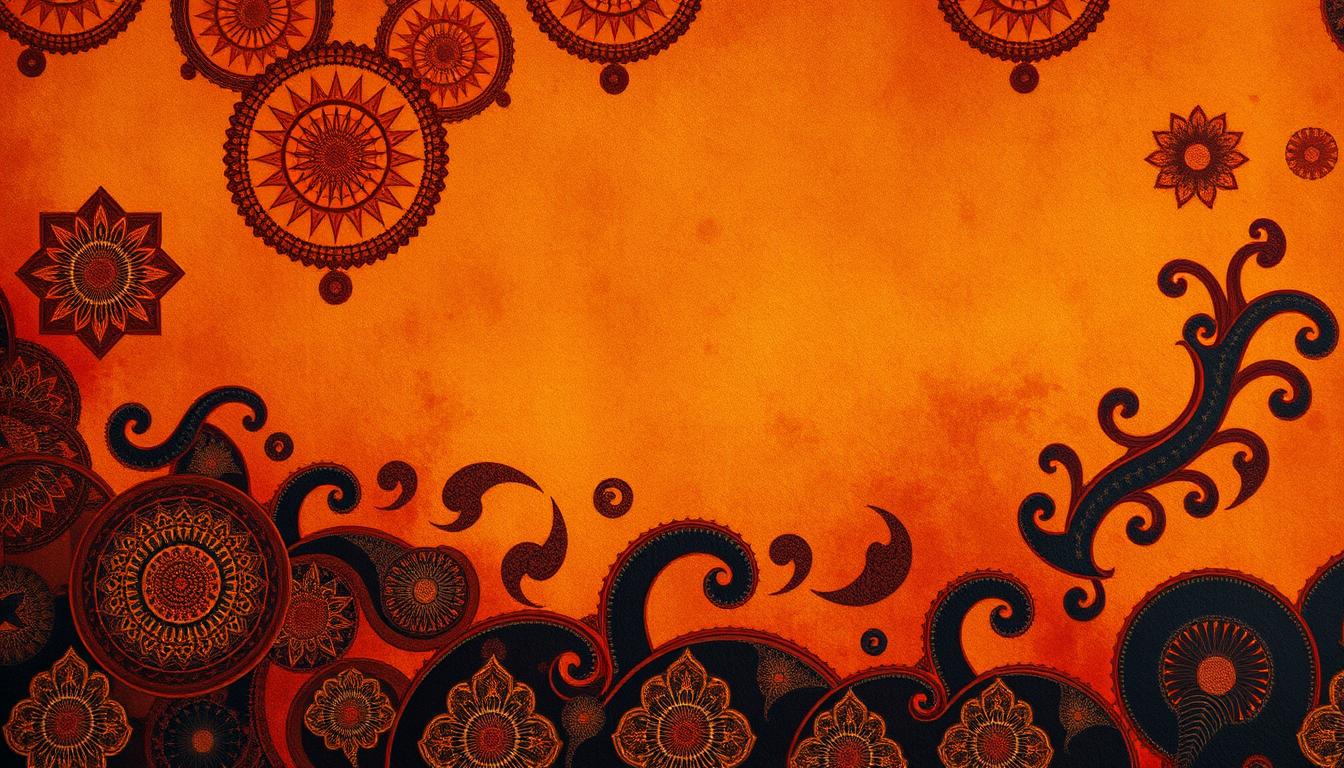Fractal patterns, which we see in nature, shed light on indigenous storytelling. These complex designs mirror themes of togetherness and ongoing life that go beyond years. This piece looks at how repeating stories show the knowledge of indigenous peoples, focusing on the Cherokee.
By looking into different stories, we uncover the deep connection between fractal patterns and indigenous storytelling’s wealth.
Introduction to Fractal Patterns and Storytelling
Fractals offer a unique way to look at storytelling. They show complex patterns similar to those in stories from different cultures. These patterns help us understand deep ideas and themes, showing how nature and people are connected.
Stories often use fractal-like patterns, repeating small motifs to build the narrative. This not only makes the story more beautiful but also emphasizes its main ideas. We see this in the oral traditions of indigenous cultures, where stories reflect key values and beliefs. Exploring the relationship between fractals and stories helps us see how tales shape cultural identities.

The Concept of Fractals in Nature
Fractals in nature are about math meeting the outdoors in an exciting way. They show up everywhere, like in trees, rivers, and coastlines. By exploring these patterns, we dive deep into nature’s complexity.
Every fractal design repeats itself, suggesting an order in what seems chaotic. This fascinating blend of repetition and uniqueness pulls us closer to the wonders of the environment.
Understanding Natural Patterns and Their Implications
Nature’s patterns tell stories of connection and survival. Fractals reflect how living things adapt using consistent yet complex forms. For instance, the way trees branch out shows these patterns on different scales.
This sameness across sizes helps plants live. It also shows how everything in nature is linked.
Examples of Fractals in the Environment
There are many examples of environmental fractals. Snowflakes, with their unique but symmetrical shapes, are one.
Coastlines with their rugged edges follow a fractal pattern too. These natural wonders highlight the beauty around us. They also suggest how human stories might mirror nature’s designs.
Fractal Patterns in Cultural Storytelling
Cultural storytelling helps keep and share the core of community identities. It shows up in different cultures, using repeating themes and symbols. These stories share common values and experiences, showing how humans like to use patterns to communicate.
Indigenous stories show these patterns in fascinating ways. They mix story arcs, showing the power of recursion in telling both personal and collective tales. They use repeating motifs to highlight important lessons, showing how individual actions affect the whole community.
When we look at stories from different cultures, a common structure appears. They either spiral inwards or outwards, reflecting bigger themes while focusing on local experiences. This style of storytelling keeps the wisdom of the past alive today. It helps cultures stay connected to their roots while evolving.
Exploring the Fractal Nature of Indigenous Storytelling
Indigenous storytelling highlights the complexity of fractal structures in its stories. This style shows the deep layers of tradition and shared experiences. It’s seen in cultures like the Cherokee, showing how fractals help share wisdom with each new generation.
How Indigenous Cultures Utilize Fractal Structures
In these cultures, fractals add depth to storytelling. Stories unfold with repeating themes that resonate on personal and community levels. Important lessons are presented in various ways, teaching morals over time. These fractal patterns link different parts of a story, making the message stronger for the listener.
Significance of Recursion in Indigenous Narratives
Recursion is a key part of indigenous stories. It repeats themes, characters, and scenes, linking past, present, and future. This way of telling stories respects old traditions while staying open to new interpretations. It shows how tradition and lived experience are woven together, keeping stories alive and meaningful over time.
The Role of Oral Tradition in Indigenous Cultures
Oral tradition is key in keeping indigenous cultures alive. It’s how communities learn about their past. Stories pass down, changing a bit with each teller to stay relevant.
This keeps the original spirit but also lets them grow. By sharing these tales, people feel a bond and understand their identity better.
Preservation and Transmission of Stories
Keeping stories alive is crucial. Elders act as story keepers, passing wisdom to the youth. They use songs, dance, and art to make tales captivating.
Young folks then bond with their roots, keeping stories alive for future generations.
Generational Storytelling Practices
Storytelling brings communities together. At gatherings, everyone adds their touch to the tales. This makes stories richer and full of new insights.
It shows how traditions adapt over time, ensuring they remain a vital part of indigenous life. This blend of old and new keeps cultures thriving.
Cultural Significance of Fractal Storytelling
Fractal storytelling shows the deep meaning within indigenous communities. These tales reflect the rich indigenous heritage. They weave together values, beliefs, and experiences that form community identity. Through their recursive layers, these stories show life’s complexities. They link the past, present, and future.
This storytelling method is key in keeping communities together. It helps understand the challenges indigenous peoples face, offering strength. By sharing these stories, individuals feel a stronger cultural connection. This reinforces their sense of belonging.
The repeating nature of these stories passes down lessons and morals. This keeps their teachings alive through many generations. By keeping fractal storytelling alive, communities protect their stories. They also celebrate their identities. This makes their cultural significance stronger and their community ties richer.
Examples of Indigenous Stories Reflecting Fractal Patterns
Indigenous folktales are deeply tied to cultural beliefs, showcasing fractal elements. These tales reflect themes and motifs that repeat across the story, adding depth. This screen shares some folktales with fractal patterns that stand out.
Notable Indigenous Folktales
- The Creation Story of the Navajo: This tale narrates the emergence of the world, featuring fractal-like cycles of creation and transformation.
- The Dreamtime Stories of the Aboriginal Peoples: These stories utilize repeating motifs to explain natural phenomena and emphasize community connections.
- The Coyote Tales of various Native American tribes: Coyote’s adventures often reflect the interplay of chaos and order, mirroring the recursive nature of life.
Analysis of Fractal Elements within These Tales
Examining these folktales, fractal elements highlight deep cultural insights. They feature recurring themes like nature’s balance, community importance, and life’s cycles. These patterns root the stories in each culture and boost their teaching value, shaping identities and strengthening community bonds among indigenous peoples.
Fractals and Interconnectedness in Indigenous Worldviews
Indigenous views show deep connections among all living things, nature, and the cosmos. They use fractals to symbolize harmony and togetherness in life. This shows the deep ties that bind different aspects of existence. Indigenous stories often highlight these ideas, revealing cosmic links in their communities.
Understanding Cosmic and Community Connections
Indigenous cultures see connections that go beyond human relationships. They feel a kinship with nature and the universe. Their stories feature characters that represent shared experiences, not just personal ones. These tales underscore how individual actions impact the wider community and cosmos.
Indigenous Epistemologies and Their Reflective Nature
Indigenous knowledge offers deep insights into their beliefs and values. It sees reality as a whole where everything matters. The repeating patterns in their stories reflect a belief in life’s lessons across different situations. This way of thinking helps people see their lives as part of a larger, shared story.
The Impact of Colonialism on Indigenous Storytelling
Colonialism deeply affected indigenous storytelling. Efforts to suppress their culture led to losing many stories. This caused a big disconnect in indigenous communities. Oral traditions, once key to these societies, were threatened by colonizers who aimed to weaken indigenous identities.
Despite this, indigenous stories have shown great resilience. Storytelling has been a strong form of resistance. This allows communities to keep their culture alive while updating their stories for today. This not only preserves their heritage but also brings their communities closer.
Indigenous storytellers are now guardians of their heritage. They use their stories to take back what was almost lost to colonialism. By mixing old stories with new ways, they highlight the value of indigenous views. They show how storytelling can fight against colonial history’s effects.
Reviving Fractal Patterns in Modern Indigenous Narratives
Today’s indigenous stories weave fractal patterns with fresh eyes. Storytellers merge age-old motifs with new tech and media. This blend enriches tales, making them more engaging for all. It shows how strong these traditional narratives remain.
Contemporary Indigenous Storytellers
Many indigenous storytellers are giving old tales a new twist. They add personal and modern issues to the stories. This brings ancient tales to life with a new viewpoint. They use digital tools and social media to spread these stories further. This mix keeps the stories’ heart alive, tackling topics like identity and community strength.
Innovative Approaches to Traditional Narratives
Trying new ways to tell old stories is crucial for their survival. Methods like interactive stories and live events draw people in. These methods respect traditional patterns while staying modern. They help younger people connect with their roots in today’s world.
Conclusion
Looking into fractal patterns in indigenous stories shows us how culture, identity, and nature are all linked. These stories do more than just keep culture alive. They pass down wisdom from many generations.
By studying these, we see that every tale, like a fractal, mirrors bigger truths about life and the cosmos. This insight makes us value indigenous storytelling even more. There’s a lot we can learn from it about keeping culture strong.
Seeing the beauty in these story structures helps make sure they touch future hearts. Bringing these tales back to life strengthens our connection to our ancestors and the world. It helps us all understand our place a bit better.
At the heart of it, these complex stories highlight why keeping cultural roots alive is vital. It’s key for these stories to continue guiding and teaching us. They add so much to our shared human journey.



